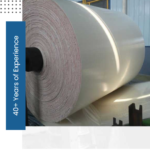Investing in a Chevron conveyor belt can be a game-changer for the productivity of your factory operations. This belt facilitates the swifter movement of materials and products, which means less downtime and more revenue. It stands out for its unique design and features V-shaped patterns that help in better grip and material handling on inclined surfaces. However, selecting the right chevron conveyor belt involves considering several factors to ensure optimal performance and durability.
Key Factors to Consider When Choosing the Chevron Conveyor Belt
Material Compatibility:
The first consideration when choosing a Chevron belt is the type of material it will be handling. Different materials have varying properties, such as abrasiveness, moisture content, and temperature sensitivity. Ensure that the selected belt material is compatible with the substances it will transport to prevent premature wear and tear.
Angle of Inclination:
Chevron conveyor belts are specifically designed for conveying materials on inclined surfaces. The angle of inclination plays a crucial role in determining the appropriate Chevron pattern and cleat height. Higher angles require deeper V-shaped cleats to prevent material slippage. Assess the angle of inclination of your conveyor system to select the most suitable Chevron belt design.
Belt Width and Length:
The dimensions of the conveyor belt, including width and length, should align with the operational requirements of the conveyor system. Consider the width of the material being conveyed and the available space within the facility to determine the optimal belt size. Additionally, ensure that the selected belt length accommodates the intended conveyor route without excessive tension or sagging.
Operating Conditions:
Evaluate the environmental and operational conditions in which the Chevron conveyor belt will be deployed. Factors such as temperature extremes, humidity levels, exposure to chemicals, and outdoor use can impact the choice of belt material and construction. Select belts with suitable resistance to abrasion, tearing, and degradation to withstand the anticipated operating conditions effectively.
Load Capacity and Speed:
Determine the load capacity and conveying speed requirements of the conveyor system to select a Chevron belt with appropriate strength and durability. Overloading the belt beyond its capacity or operating at excessively high speeds can lead to accelerated wear, reduced efficiency, and potential safety hazards. Consult with belt manufacturers to ensure compatibility with your specific load and speed requirements.
Maintenance and Serviceability:
Consider the ease of maintenance and serviceability when choosing a Chevron conveyor belt. Opt for belts that facilitate quick and convenient access for cleaning, inspection, and repair tasks. Additionally, inquire about the availability of spare parts and technical support from the manufacturer to ensure timely maintenance and minimize downtime.
Regulatory Compliance:
Ensure that the selected Chevron conveyor belt complies with relevant industry standards and regulations, particularly regarding safety, quality, and environmental considerations. Verify certifications and compliance documentation provided by the manufacturer to guarantee adherence to applicable standards and regulations.
Cost-effectiveness:
While quality and performance are paramount, consider the overall cost-effectiveness of the conveyor belt, including initial purchase price, maintenance expenses, and lifecycle costs. Balance the upfront investment with long-term durability and operational efficiency to achieve the best value for your investment.
Conclusion:
Choosing the right Chevron conveyor belt involves careful consideration of various factors, including material compatibility, angle of inclination, belt dimensions, operating conditions, load capacity, maintenance requirements, regulatory compliance, and cost-effectiveness. By thoroughly assessing these factors and consulting with reputable manufacturers, businesses can select conveyor belts that meet their specific requirements and deliver reliable performance in diverse industrial applications. Investing in the right conveyor belt ensures efficient material handling operations, enhances productivity, and contributes to the overall success of the enterprise.



